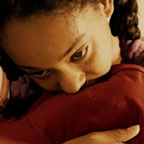
The cry is silent. The wound is soul-deep, scabbed but never healing, an infection that seeps into the whole body. In some cases, the symptoms are obvious. In others, they’re much subtler, yet still affecting the functioning of the body. When the decision is made to remove the scab, there’s pain, but the healing then begins from the inside out, as it must with deep wounds. And in some ways, the healed wound is stronger than before.
The process above doesn’t just describe a physical wound, but also the emotional wounds adults who’ve been sexually abused as children carry with them. Unfortunately, many have been told to “forgive and forget.” This maxim has truth in it, but healing from sexual abuse is a process, and to be able to “forgive and forget,” the trauma and pain must be recognized and worked through.
Sexual abuse is defined as any kind of sexual behavior by an adult with a child or any unwanted or inappropriate sexual behavior from another child. This includes sexual intercourse, oral sex, anal sex, being touched in a sexual way, and being persuaded to touch someone else. It doesn’t just include physical contact. Being made to watch other people’s sexual behavior or to look at their bodies, at sexual photographs, or videos also can be forms of sexual abuse. Photographing children engaged in sexual acts is abuse.
The abuse may happen only once—or many times over a number of years. The abuser can be a man or a woman. An individual may have been abused by one person, many different individuals, or a group of people. Although the majority of abusers are thought to be men (80 percent), many survivors have been abused by women. Men as well as women have been victimized and are hurting from the effects of childhood sexual abuse.
There are a number of adults who were sexually abused as children, have never told anyone, and have never dealt with the trauma. Those who may have risked disclosing the incidents often were ignored or, worse yet, blamed for the abuse. The effects of the abuse were compounded by the sense of betrayal from those who should have protected the child.
As an individual enters therapy, different terminology is used. Those who’ve been sexually abused are called “survivors”—not “victims.” If someone has reached adulthood after having been sexually abused, that person has survived the worst. “Survivor” carries the connotation of strength and empowerment.
Adults who were abused as children carry the trauma with them. The direct and indirect effects of sexual abuse are numerous: fear, anxiety, phobias, nervousness, nightmares, sleep problems, depression, shame, guilt, feeling like a victim, lack of self-confidence, feeling different from others, compulsions, obsessions, flashbacks, hallucinations, memory gaps, eating disorders, sexual dysfunction and confusion, relationship problems, substance abuse problems, anger, and other difficulties in functioning. Coping strategies used to survive sometimes become problems in their own right, and these also need to be addressed in therapy.
The healing process can be described in the following way: deciding to heal, remembering the abuse, believing it happened, knowing it wasn’t your fault, getting in touch with anger and grief, talking about the abuse, and being able to move on. As one heals, one experiences these stages repeatedly, each time with a different perspective. The healing process involves struggles and setbacks in addition to learning how to cope.
Being sexually abused as a child affects people to differing degrees. How one has been affected will depend on a number of factors, including who abused the child, how long the abuse went on, how old the child was when it started and ended, what was done and said, and whether any support or care was available. Each survivor’s experience is unique, yet there are commonalities, and knowing these commonalities gives strength to the survivor.
Dealing with sexual abuse is painful. Strong feelings will be stirred up and have powerful effects. It’s possible to break free from the damaging effects of sexual abuse, but it will take time. The survivor may have had problems over many years, and the problems won’t just disappear overnight. Harmful beliefs and behaviors resulting from being sexually abused as a child need to be identified and changed.
Working through the feelings about abuse and feeling better about oneself are goals of therapy. Therapy includes learning to prepare for difficulties that arise as the trauma of sexual abuse surfaces. A support system and knowledge of how to care for oneself through the therapy process are important. Facing past experiences and linking past experiences to present problems is the next step. Becoming aware of current coping strategies, both harmful and non-harmful, is necessary. Identifying and dealing with the things that trigger extreme feelings and behaviors, flashbacks, and hallucinations is vital.
Feelings of guilt and self-blame often are experienced by survivors. Many feel they’re responsible for being abused because they didn’t stop the abuse, didn’t tell anyone, or because they think they caused the abuse to happen. The key concept is that the responsibility for the abuse always lies with the abuser and never with the abused person.
Identifying one’s feelings toward abusers and regaining one’s own power are necessary tasks in healing. The other important component is that the survivor knows healing is possible, that there’s a way out of the darkness, and that the individual is capable of finding that way.
Survivors of childhood sexual abuse often describe their journey as walking through the valley of the shadow of death and emerging into the sunlight. As they near the end of the therapeutic process, they often describe the sensation of looking forward to living each day instead of living in fear. There’s a powerful effect of breaking the silence about child abuse, and the survivor’s strength to heal and grow is inspiring. Public awareness of child abuse has increased in recent years, but much remains to be done to prevent child abuse and to help adult survivors still suffering. TPW
